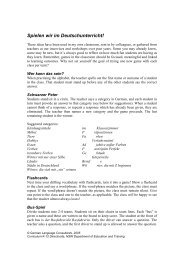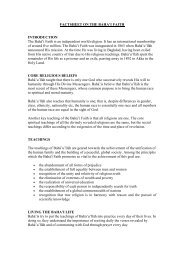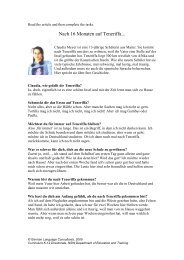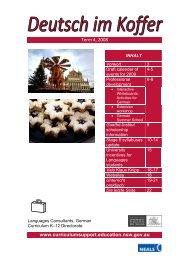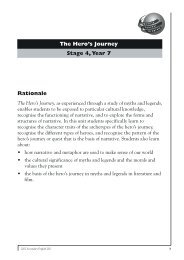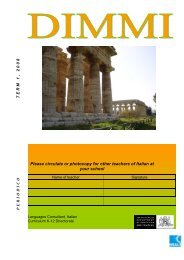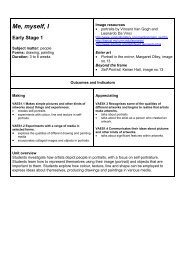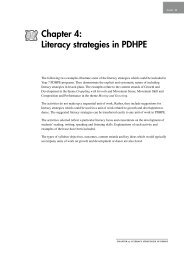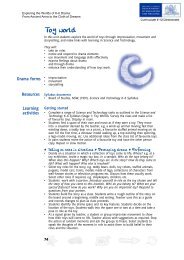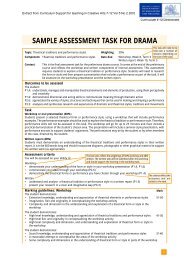Enzymatic Browning of Apples - Curriculum Support
Enzymatic Browning of Apples - Curriculum Support
Enzymatic Browning of Apples - Curriculum Support
Create successful ePaper yourself
Turn your PDF publications into a flip-book with our unique Google optimized e-Paper software.
<strong>Enzymatic</strong> <strong>Browning</strong> <strong>of</strong><br />
<strong>Apples</strong><br />
ACTIVITY<br />
The purpose <strong>of</strong> this experiment is to monitor the level <strong>of</strong><br />
enzymatic browning <strong>of</strong> apple slices. <strong>Apples</strong> contain an<br />
enzyme called polyphenol oxidase (phenolase)<br />
In the presence <strong>of</strong> oxygen from the air, this enzyme<br />
catalyses the formation <strong>of</strong> brown pigments called melanins.<br />
Treatment <strong>of</strong> the apple slices with ascorbic acid, citric acid,<br />
or acetic acid will reduce the level <strong>of</strong> browning. The<br />
reduction in browning is dependent on the type <strong>of</strong><br />
substance and its concentration. Soaking in water alone<br />
will temporarily reduce the level <strong>of</strong> browning by restricting<br />
the amount <strong>of</strong> oxygen in contact with the apple slices.<br />
BACKGROUND INFORMATION<br />
When fruits or vegetables are peeled or cut, enzymes<br />
contained in the plant cells are released. In the presence <strong>of</strong><br />
oxygen from the air, the enzyme phenolase catalyses one<br />
step in the biochemical conversion <strong>of</strong> plant phenolic<br />
compounds to form brown pigments known as melanins.<br />
This reaction, called enzymatic browning, occurs readily at<br />
warm temperatures when the pH is between 5.0 and 7.0<br />
The presence <strong>of</strong> iron or copper can increase the rate <strong>of</strong><br />
reaction. This can be easily observed when fruit is cut with<br />
a rusty knife or mixed in a copper bowl.<br />
Bruising or other injury to the plant tissue disrupts the<br />
arrangement <strong>of</strong> chemicals within the cells and allows these<br />
chemicals to make contact with oxygen. This may lead to<br />
browning <strong>of</strong> uncooked fruits. <strong>Enzymatic</strong> browning can be a<br />
significant problem, limiting the shelf life <strong>of</strong> many fruits and<br />
vegetables which have had little heat applied during<br />
processing. However, enzymatic browning is not always a<br />
defect. The browning reaction contributes to the desirable<br />
colour and flavour <strong>of</strong> raisins, prunes, c<strong>of</strong>fee, tea, and<br />
cocoa.<br />
NSW Syllabus References:<br />
Biology HSC syllabus<br />
Core Topic 9.2 Maintaining a Balance<br />
Students:<br />
• Identify data sources, plan, choose<br />
equipment or resources and perform a firsthand<br />
investigation to test the effect <strong>of</strong><br />
– increased temperature<br />
– change in pH<br />
– change in substrate concentration on<br />
the activity <strong>of</strong> named enzyme(s)<br />
NSW Syllabus References:<br />
Years 7-10 Science syllabus<br />
• Student Research project<br />
• Prescribed Focus Area – application and<br />
uses <strong>of</strong> science
<strong>Enzymatic</strong> <strong>Browning</strong> <strong>of</strong><br />
<strong>Apples</strong><br />
Several substances have been used in the food industry to<br />
prevent browning <strong>of</strong> fruits and vegetables:<br />
Sulfites prevent browning by releasing sulfite ions, which<br />
prevent melanin formation. The Australia New Zealand<br />
Food Standards Code permits the presence <strong>of</strong> sodium or<br />
potassium sulfites in apples for manufacturing purposes to<br />
a level <strong>of</strong> 200mg/kg (ppm). Sulfites are not allowed in foods<br />
in Australia unless expressly permitted by the Foods<br />
Standards Code.<br />
Ascorbic acid (vitamin C) acts as an antioxidant. Oxygen<br />
is more likely to react with the ascorbic acid, rather than<br />
with the phenolic compounds in the fruit or vegetable.<br />
<strong>Browning</strong> does not proceed until most <strong>of</strong> the ascorbic acid<br />
is used up in the reaction.<br />
Citric acid and acetic acid lower the pH <strong>of</strong> the fruit tissue<br />
to retard the action <strong>of</strong> the phenolase. If the pH is reduced<br />
below 3.0, the activity <strong>of</strong> the phenolase will be severely<br />
inhibited.<br />
Placing fresh fruit in a water bath will temporarily inhibit the<br />
browning reaction, since water restricts the amount <strong>of</strong><br />
oxygen in contact with fruit tissues. Heating also prevents<br />
browning by<br />
inactivating the phenolase. Since heat also cooks the fruit,<br />
heating cannot be used as a treatment for fruits which will<br />
be served fresh.<br />
PROCEDURES<br />
1. Place an untreated apple slice on a paper towel. Label<br />
the towel "Control."<br />
2. Using tongs, dip another apple slice into one <strong>of</strong> the test<br />
solutions for 30 seconds, place it on the towel, and<br />
label the towel with the name <strong>of</strong> the solution.<br />
3. Rinse the tongs and repeat the same procedure for the<br />
other three solutions.<br />
4. Soak one slice in water for 30 seconds. Place it on a<br />
towel and label the towel "Water Soak."<br />
5. Note the time and temperature in your data table.<br />
Observe the slices every 10 minutes for one hour and<br />
record your observations.<br />
6. Compare your results with those obtained by the rest <strong>of</strong><br />
the class.<br />
MATERIALS<br />
• Fresh apple slices <strong>of</strong> approximately the<br />
same size (6 per group)<br />
• Test solutions for dipping apple slices into:<br />
0.1% Ascorbic acid<br />
0.1% Citric acid<br />
0.1% Acetic acid<br />
1.0% Acetic acid<br />
• Beaker or cup with water<br />
• Tongs<br />
• Paper towels
<strong>Enzymatic</strong> <strong>Browning</strong> <strong>of</strong><br />
<strong>Apples</strong><br />
Results<br />
Time (min.) No<br />
treatment<br />
(control)<br />
0<br />
5<br />
10<br />
15<br />
20<br />
25<br />
30<br />
35<br />
40<br />
45<br />
50<br />
Data table<br />
<strong>Enzymatic</strong> <strong>Browning</strong> <strong>of</strong> Apple Slices<br />
Ascorbic acid<br />
(0.1%)<br />
Level <strong>of</strong> browning<br />
Citric Acid<br />
(0.1%)<br />
Acetic Acid<br />
(0.1%)<br />
Acetic Acid<br />
(1.0%)<br />
Water soak<br />
Time started: ………………………… Temperature at start: ………………………..<br />
Key<br />
5 = completely dark brown<br />
4 = fully covered light brown<br />
3 = half-covered light brown<br />
2 = some brown patches<br />
1 = no browning present
<strong>Enzymatic</strong> <strong>Browning</strong> <strong>of</strong><br />
<strong>Apples</strong><br />
KEY QUESTIONS & ANSWERS<br />
Q. What causes browning when fresh fruits and some<br />
vegetables are peeled or cut?<br />
A. The browning is caused by the conversion <strong>of</strong> phenolic<br />
compounds to melanins catalysed by the enzyme<br />
polyphenol oxidase.<br />
Q. What conditions promote the browning process? Why?<br />
A. Oxygen is required for the reaction to occur.<br />
Heat – browning increases with increasing temperature<br />
until the polyphenol oxidase is inactivated.<br />
pH – the optimal pH for the browning reaction is<br />
between 5.0 and 7.0. If the pH is significantly below 3.0<br />
the enzyme will be inactivated.<br />
Metal ions – such as iron and copper can increase the<br />
rate <strong>of</strong> the reaction.<br />
Q. How do food additives or treatment processes in use<br />
today prevent or retard browning in fruits and<br />
vegetables?<br />
A. Sulfites – inhibit melanin formation.<br />
Ascorbic acid (vitamin C) – prevents oxygen from<br />
reacting with the polyphenol oxidase.<br />
Citric acid and acetic acid – lower the pH, which<br />
decreases the enzyme activity. Citric acid also ties up<br />
copper ions and prevents them from participating in the<br />
reaction.<br />
Heating – inactivates the polyphenol oxidase.<br />
Q. Why do citrus juices retard browning in fresh fruits?<br />
A. Because ascorbic acid and citric acid are present in the<br />
fruit juices and they lower the pH which may reduce the<br />
activity <strong>of</strong> the enzyme.



